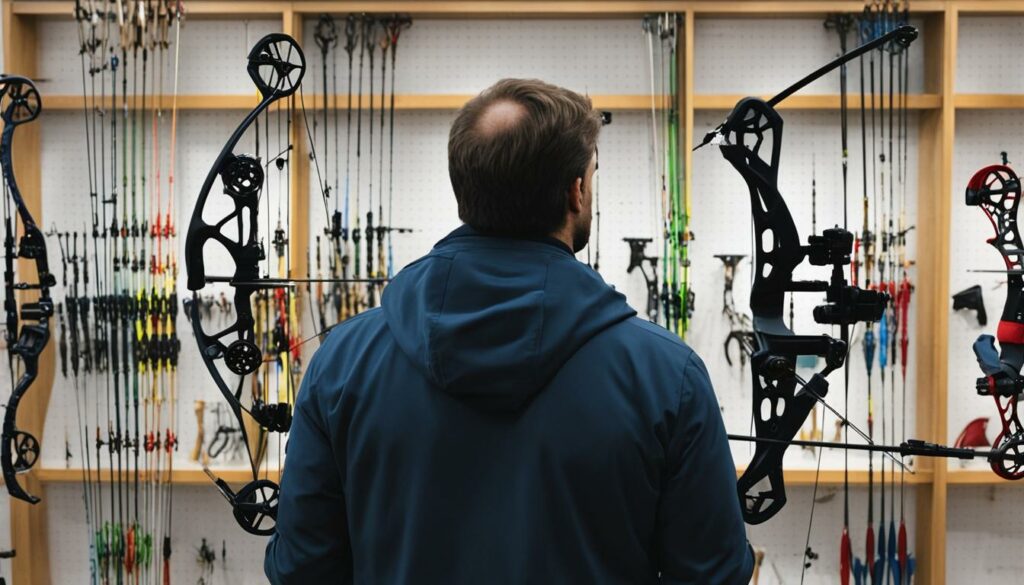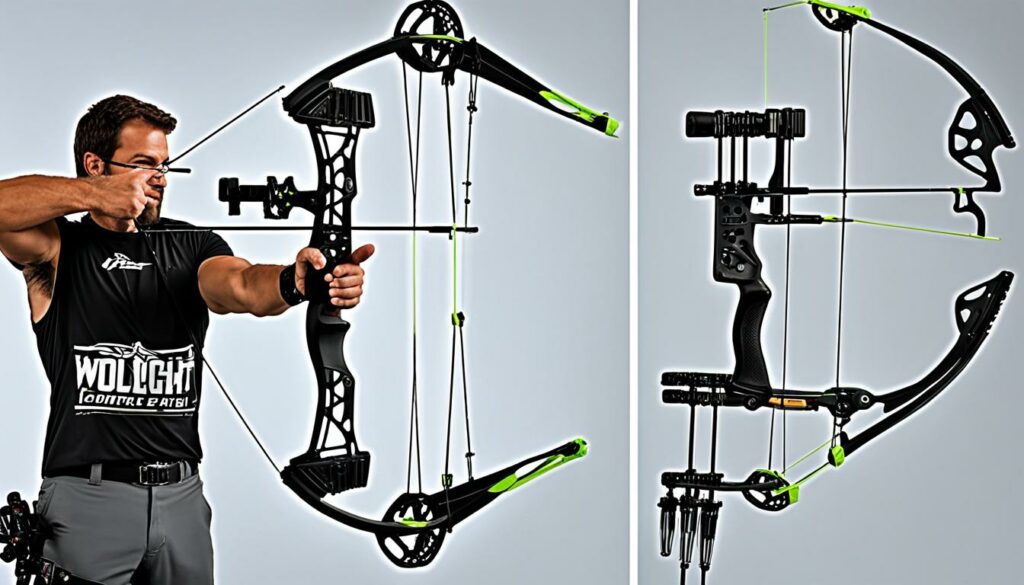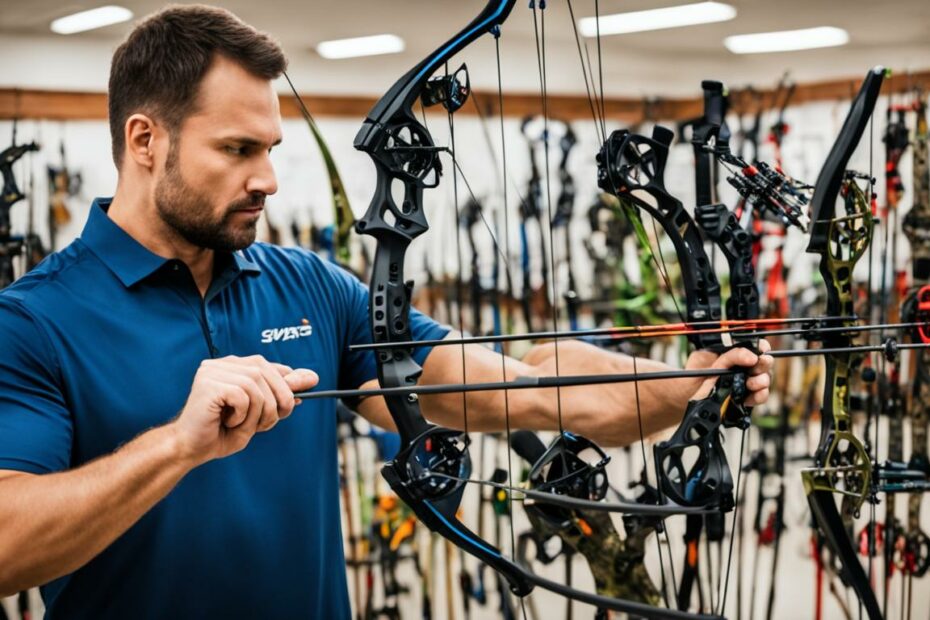Bowhunting is a challenging and exciting sport that requires skill and precision. Choosing the right compound bow is crucial for successful bowhunting or target shooting. Compound bows offer improved accuracy and efficiency compared to traditional bows.
In this comprehensive buying guide, we will explore the critical factors to consider when selecting a compound bow, including draw length, draw weight, bow length, brace height, bow weight, speed, noise, cams, riser, and whether to choose a bare bow or a ready-to-shoot bow.
Whether you’re a seasoned archer or a beginner, this buying guide will give you the insights you need to make an informed decision. If you’ve been wondering, “Should I buy a compound bow?” or searching for a reliable compound bow buying guide, you’ve come to the right place.
Why Choose a Compound Bow?
Compound bows are favored by bowhunters seeking superior accuracy and efficiency. These bows have undergone extensive advancements, outperforming traditional bows in various aspects. Their compact and lightweight design makes them particularly suitable for bowhunting endeavors.
However, it is crucial to consider compound bows’ features, benefits, and drawbacks before finalizing a purchase decision.
The Pros of Compound Bows
- Accuracy: Compound bows are renowned for their exceptional accuracy due to their advanced design and mechanical components.
- Efficiency: Compound bows’ unique cam and limb system enables efficient power transfer, resulting in higher arrow velocity and improved shot penetration.
- Let-Off: One key advantage of compound bows is their let-off feature, which reduces the holding weight once the bow is at full draw. This allows hunters to steady their aim and hold the bow longer without muscle fatigue.
- Adjustability: Compound bows offer various adjustability options, allowing archers to customize their setups to suit their preferences and shooting styles.
The Cons of Compound Bows
- Complexity: Compound bows can be more intricate than traditional bows, requiring familiarity with their mechanical components and potential maintenance.
- Price: Compound bows are more expensive than traditional bows due to their advanced technology and materials.
- Draw Weight: Setting up and adjusting the draw weight of a compound bow may require additional tools or professional assistance, especially for beginners.
- Noise: The mechanical components and higher arrow speeds of compound bows can generate more noise upon release, potentially spooking game animals in hunting scenarios.
Consider these pros and cons to make an informed decision when choosing a compound bow. Remember, what works best for one archer may not be ideal for another.
It’s crucial to select a compound bow that aligns with your individual preferences, shooting skill level, and intended use.
| Pros of Compound Bows | Cons of Compound Bows |
|---|---|
| Accuracy | Complexity |
| Efficiency | Price |
| Let-Off | Draw Weight |
| Adjustability | Noise |
Things to Consider When Shopping for Your Compound Bow
When choosing a compound bow, it is essential to familiarize yourself with the various factors and terms involved. Understanding these considerations will help you decide and find the perfect bow to suit your needs.
The first step is to determine the primary application of the bow. Are you looking for a compound bow for hunting or target shooting? This distinction will influence the specific features and specifications you should prioritize.
Next, finding a bow that is the right fit for your body is crucial. Consider factors such as draw length, draw weight, bow length, brace height, and bow weight. Each of these aspects can significantly impact your comfort and accuracy when shooting.
Draw length refers to the distance from the string to the deepest part of your grip when the bow is fully drawn. Selecting a bow with an appropriate draw length is essential to ensure proper form and efficient shooting.
On the other hand, draw weight refers to the force required to reach full draw and should be determined by your strength and shooting ability.
Bow length, brace height, and bow weight are additional factors. Bow length, measured from axle to axle, can affect shooting performance in different situations, while brace height, the distance between the bowstring and the handle grip when the bow is at rest, can impact stability and ease of shooting. Bow weight refers to the overall weight of the bow and may influence handling and portability.
Understanding the importance of speed and noise is paramount, particularly in hunting scenarios. While a faster bow may offer greater arrow speed, it can also produce more noise and be more challenging to handle, especially for beginners.
Furthermore, familiarize yourself with the different types of cams used in compound bows. Cams play a vital role in drawing weight and overall shooting efficiency. Take the time to understand their characteristics and how they affect the bow’s performance.
Lastly, consider the design of the riser, which is the bow’s handle. The riser’s design can impact shooting comfort, accuracy, and stability.
Finally, there is a choice between a bare compound bow or a ready-to-shoot compound bow. A bare bow does not come with accessories, allowing you to customize and select your accessories based on your preferences.
On the other hand, a ready-to-shoot bow comes with all the necessary accessories, making it convenient for beginners or individuals who prefer a complete package.
Remember, trying out different compound bows and seeking guidance from local archery shops is always helpful. Their expertise can help you find the perfect bow for your shooting style and preferences.

Draw Length and Draw Weight
Draw length refers to the distance from the string to the deepest part of your grip when the bow is fully drawn. Choosing a compound bow with the proper draw length is essential for shooting accurately and comfortably.
On the other hand, draw weight is the force required to pull back on the bowstring and reach full draw. Selecting a draw weight that matches your strength and shooting ability is essential. Opting for a draw weight that is too heavy can make achieving consistent accuracy difficult, while choosing one that is too light may sacrifice power and effectiveness.
To determine your ideal draw length and draw weight, it is recommended that you consult with a professional archer or visit an archery pro shop. There, you can receive expert guidance and try out different bows. Finding the right combination of draw length and weight can optimize your shooting experience and enhance your performance.
| Draw Length | Draw Weight | |
|---|---|---|
| Beginner/Youth | 24-26 inches | 10-30 pounds |
| Intermediate | 26-28 inches | 30-50 pounds |
| Advanced/Experienced | 28-30 inches | 50-70 pounds |
Bow Length, Brace Height, and Bow Weight
When selecting a compound bow, it’s essential to consider factors beyond draw length and draw weight. Bow length, brace height, and bow weight play crucial roles in determining the bow’s overall performance and user experience.
Bow Length
Bow length refers to the measurement from axle to axle, and it can significantly impact shooting performance in different situations. A shorter bow offers more maneuverability, making it easier to navigate through tight spaces, such as dense vegetation.
On the other hand, a longer bow provides increased stability and forgiveness, enhancing accuracy during long-distance shots.
Brace Height
The brace height of a compound bow is the distance between the bowstring and the handle grip when the bow is at rest. This measurement affects both stability and ease of shooting.
A shorter brace height typically results in a faster bow with improved arrow speeds but can also make the bow less forgiving and more sensitive to form and grip. On the other hand, a longer brace height increases forgiveness and stability, making it easier to maintain accuracy.
Bow Weight
The weight of the compound bow is an important consideration that can affect handling and portability. Lightweight bows are easier to carry, especially during long hunting or target shooting hours. They also allow for quicker aiming and target acquisition.
However, lighter bows may produce more vibration and feel recoil upon release. On the other hand, heavier bows tend to be more stable, reducing hand torque and enhancing overall accuracy. They generally absorb more vibration, resulting in a smoother shooting experience.
Bow length, brace height, and weight are critical factors when selecting a compound bow. These measurements impact maneuverability, stability, forgiveness, and overall shooting performance.
Finding the right combination of these factors based on your shooting style and preferences is crucial in achieving accuracy and success in bowhunting or target shooting.

Speed and Noise, Cams, and Riser
The speed and noise of a compound bow are vital considerations, particularly for hunting purposes. While a faster compound bow can deliver greater arrow speed, it can also generate more noise and be more challenging to handle, especially for beginners. Therefore, finding the right balance between speed and noise is crucial for optimal performance.
Another crucial aspect to understand when choosing a compound bow is the different types of cams. Cams play a significant role in determining the bow’s draw weight and efficiency. There are generally two types of cams: single cams and hybrid cams.
A single-cam system utilizes a wheel at the bottom and an idler wheel at the top of the bow. This design offers a smoother draw cycle and requires less maintenance than other cams. On the other hand, hybrid cams utilize a combination of wheels and elliptical wheels to enhance speed and accuracy. They can provide a more aggressive draw cycle and generally require more maintenance.
The riser, which refers to the handle of the compound bow, is another crucial component to consider. The riser plays a significant role in the bow’s overall comfort, accuracy, and stability. Choosing a compound bow with a well-designed riser that suits your shooting style and preferences is essential.
Here is a table summarizing the main points about speed and noise, cams, and the riser in compound bows:
| Aspect | Description |
|---|---|
| Speed | Higher arrow speed results in flatter trajectories and increased accuracy at longer distances. However, it may also increase noise and be challenging to handle. |
| Noise | The noise produced by a compound bow can potentially spook game animals, making a quieter bow desirable for hunting. |
| Cams | Cams determine the bow’s draw weight and efficiency. Single cams offer a smoother draw cycle and low maintenance, while hybrid cams enhance speed and accuracy. |
| Riser | The bow’s riser, or handle, significantly impacts comfort, accuracy, and stability. Choosing a well-designed riser is crucial for optimal shooting performance. |
Bare vs. Ready-to-Shoot Compound Bows and Final Considerations
Factors such as personal preferences and budget play a significant role when deciding between a bare compound bow and a ready-to-shoot compound bow.
As the name suggests, a bare compound bow does not come with any accessories, giving you the freedom to customize your setup according to your specific needs. On the other hand, a ready-to-shoot compound bow includes all the essential accessories you need to start immediately.
For those who prefer a more personalized approach and have specific preferences for accessories such as sights, arrow rests, or stabilizers, a bare compound bow offers the flexibility to choose and customize each component. This allows you to build a setup that suits your shooting style and performance requirements perfectly.
However, a ready-to-shoot compound bow is an excellent option if you are a beginner or prefer convenience. These bows come with installed accessories, ensuring you have everything you need to start shooting immediately.
Additionally, ready-to-shoot bows often come with adjustment features, allowing you to fine-tune the bow to your personal preference and physical attributes easily.
Lastly, when considering whether to choose a bare or ready-to-shoot compound bow, it is essential to take into account the available package deals.
Some manufacturers offer bundled packages that include the bow and necessary accessories and additional items such as arrows, quivers, or cases. These package deals can provide excellent value for money and help you save on purchasing individual items separately.
As you decide, visiting local archery shops and trying out different compound bows is highly recommended. This hands-on experience will allow you to assess the comfort, fit, and shooting experience.
Furthermore, the knowledgeable staff at these shops can provide expert guidance based on your skill level and shooting style, helping you make an informed choice that will enhance your archery journey.
FAQ
Should I buy a compound bow?
Buying a compound bow is an excellent choice for improved accuracy and efficiency in bowhunting or target shooting. Compound bows are compact and lightweight, making them ideal for bow hunting. However, it is essential to consider the pros and cons before deciding.
Why should I choose a compound bow?
Compound bows offer improved accuracy and efficiency compared to traditional bows. They have undergone significant improvements over the years, resulting in better performance. They are also compact and lightweight, ideal for bowhunting or target shooting.
How do I choose a compound bow?
When choosing a compound bow, consider factors such as your intended application (hunting or target shooting) and finding a bow that fits your body. Factors to consider include draw length, draw weight, bow length, brace height, and bow weight.
It is also essential to understand the importance of speed, noise, different types of cams, the riser design, and whether to choose a bare or ready-to-shoot bow.
What is draw length, and why is it important?
Draw length refers to the distance from the string to the deepest part of your grip when the bow is fully drawn. Choosing a compound bow with the proper draw length is essential for shooting accurately and comfortably. Selecting a draw length that matches your body and shooting style is also crucial.
What is draw weight, and why is it important?
Draw weight is the weight you need to pull back on the bowstring to reach full draw. Selecting a draw weight that matches your strength and shooting ability is essential. Choosing the right draw weight will ensure consistent and accurate shooting.
What factors should I consider regarding bow length, brace height, and weight?
Bow length is the measurement from axle to axle and can impact shooting performance in different situations. Brace height is the distance between the bowstring and the handle grip when the bow is at rest and affects stability and ease of shooting. Bow weight refers to the overall weight of the bow and can impact handling and portability.
How does speed and noise affect a compound bow?
Speed refers to the velocity at which the arrow is shot from the bow. While a faster bow may offer greater arrow speed, it can also be noisier and more difficult to handle for beginners. It is essential to balance speed and noise based on your shooting style and preferences.
What are the different types of cams, and how do they impact the compound bow?
Different types of cams are used in compound bows, such as single cams, hybrid cams, and binary cams. These cams affect the draw weight and efficiency of the bow. Understanding the different cam types and their characteristics will help you choose a compound bow that suits your shooting style.
How does the riser design impact a compound bow?
The riser is the handle of the compound bow. It plays a role in comfort, accuracy, and stability. Different riser designs can impact how the bow feels in your hand and how it performs during shooting. Choosing a riser design that suits your preferences and shooting style is essential.
What is the difference between a bare compound bow and a ready-to-shoot compound bow?
A bare compound bow does not come with accessories, while a ready-to-shoot compound bow includes everything you need to start shooting, such as sights, arrow rests, and stabilizers. Choosing between a bare compound bow and a ready-to-shoot compound bow depends on your preferences and budget.
What should I consider when choosing compound bow accessories?
When choosing compound bow accessories, consider the accessories’ quality, compatibility, and adjustability. Additionally, look for package deals that offer a combination of accessories at a competitive price. Seeking guidance from local archery shops can also help you select the right accessories for your compound bow.
